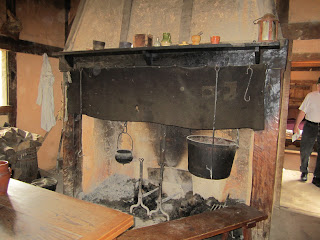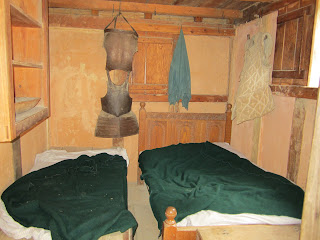In the year 1607 three ships full of colonists landed on the bank of the James River in what we know today to be Virginia to undertake a business venture. The settlement that they established was names Jamestown. This was the first permanent English settlement in America and from this group of men, our nation was born.
Today, you can visit two museums that tell the story of Jamestown. One is the actual site of the settlement and what you will see there are archaeological digs, their resulting finds, and the layout of discoveries that continue every day of the settlement. This is run in a joint venture by the National Park Service and the Society of the Preservation of Virginia Antiquities. That attraction is called Historic Jamestowne and we visited there in our Roadtrek a year ago. This year our Roadtrek brought us to the other museum dedicated to Jamestown - Jamestown Settlement.
Jamestown Settlement is a privately run living history musuem. Here you will see the settlement of Jamestown brought to life by living history interpreters recreating life in Jamestown within a replica of the original fort that was built, in the native village of Powhatan, and on the three ships that brought the colonists from England. In addition, there is a large musuem filled with artifacts, displays, and presentations to fully explain life in the "New World".
Jamestown Settlement is located in Jamestown, Virginia adjacent to the original site and National Park Service historic park. There is plenty of parking and while there is not dedicated RV parking there is no problem parking your Roadtrek - or even a larger RV. We parked in an empty part of the lot in two spaces back to front and there was no problem. The museum and interpretation center is is a large building next to the parking lot. As you enter this building there are admission ticket counters, a gift shop, and a cafeteria. After you purchase your ticket you walk to a long hallway that spans the entire rear of the building and this takes you to an orientation film, the musuem, and at the end of the hall, the exit to the living history area. Other than the museum this is an outdoor attraction. Plan this for a day that will not rain. We tried, and with hopes of just a cloudy day - as you can see from the photos - it did rain lightly that afternoon. In anticipation of that possibility, we stopped first to see the introductory film in the musuem theater - the story of the founding of the settlement and its first years - and then we headed outside, saving the indoor museum for later.
Outside you can explore on your own or take a guided tour which is included in your admission. Tours have scheduled starting times which will be posted. You may leave the tour at any time, if you wish. We went outside for our group tour and our tour guide was a woman portraying a member of the Powhatan tribe. She took escorted us down a path to the Powhatan Village. Everything that you see at Jamestown Settlement has been created down to detail from research of journals and documents kept by the settlers. Some of these included drawings and sketches of what the settlers saw and the Powhatan Village represents the result of that research. The Powhatan people lived in huts made of sea grass. In the village you will see and walk into those huts - fully furnished inside just as they were. You will also see skills of the native people demonstrated. With the guide you are taken around the village and through one of the dwellings as she answers questions and explains what you are seeing and the life of the Powhatan people. From here the guide escorts you through the forest to the settlers fort. You are welcome to come back to the village later to explore on your own.
Once at the fort you are introduced to one of the settlers and then the Powhatan woman leaves you with him. He is now your guide for the fort. The fort has been recreated just as it was again based on extensive research. As archaeology at the original site discovers new findings about the fort, Jamestown Settlement revises their reconstruction. For many years and until the last ten years or so, it was thought that the original fort site had eroded into the James River and no longer existed. An archaeology project started to investigate areas that before had been left undug because they were covered by Civil War earth works. There was a reluctance to disturb one history for an earlier history. Test digs proved the theory of where the fort may be correct and an extensive project was undertaken and still continues today - at the original site. So, very much so, every part of history as it was known of Jamestown keeps changing.
In the fort your guide will explain the life of the colonists and the hardships that they endured in the first year of the settlement. You will learn about the "starving time" which almost wiped out the small colony. You will be taken though a few of the buildings but not all, and again, it is expected that you will come back to the fort later to explore on your own. Throughout the fort there are people portraying colonists who are going about their daily lives. Some demonstrating trades, some tending gardens, some doing their military duty. You will see bread baked in a bake oven, carpentry, blacksmithing, armor repair, the firing of a matchlock musket - something that is not commonly seen - even as a colonial reenactor who fires a flintlock musket regularly, I had to see the matchlock fired, and through the day there are scheduled firings of one of the fort's cannons. Your guide will next take you out of the fort and down to the river where you will be introduced to one of the sailors who sailed on one of the three ships that brought the colonists to the New World.
There are three ships - the Susan Constant, the Godspeed and the Discovery. (I hope you were not thinking the Nina, the Pinta, and the Santa Maria - or the Mayflower!) The sailor will tell you about the voyage and its hardships. You will learn that in mid-voyage they had to wait on the ocean for the wind to come blowing in the right direction to get to their destination - and how long that took. Your guide will then invite you to explore each of the ships and that ends the guided tour. You can walk on board of each ship. You can go into the holds at the bottom of the ships. You can see the captain's quarters, and where the colonists spent the voyage. These are real ships floating on the James River and tied up to the docks. These ships are capable of sailing. On the ships you will only slightly feel the rocking of the ship on the water - enough to help you understand what it would be like to be out on open sea for months.
When you are ready to leave the ships, you return on your own now to the fort. Spend time in the fort. Look at the various buildings - inside and out. Talk to the people. There is even armor out for you to try on. When you are ready to move on again, return to the Powhatan Village and see everything there.
 When you have seen all of the outside living history attractions, come back up the path that you took down to the Powhatan Village and return to the musuem building. Start your exploration of the museum, not at the end where you just came back inside, but go down the hallway to the beginning. The museum is arranged by years. At the start of the museum's presentation, you will see first what Virginia was like before the colonists arrived. You will learn about the native people and how they lived. The museum then moves along to show you what life was for the colonists in England. Some of these men were quite wealthy - this colony was a business venture. They were coming to make money more than anything else. You will see various rooms from homes of different classes of people. And you will learn that what they were after was gold - and in this part of Virginia there is no gold - though they would not know that. What they found was tobacco and with that the colony succeeded. In the museum you will learn more about the voyage. You will see artifacts from the colonists. You will learn about the real Pocahontas - not the Disney version or the myths. You will see how the settlement developed and how it grew to be the first capital of Virginia and then later was abandoned for a somewhat more comfortable environment up river to Williamsburg.
When you have seen all of the outside living history attractions, come back up the path that you took down to the Powhatan Village and return to the musuem building. Start your exploration of the museum, not at the end where you just came back inside, but go down the hallway to the beginning. The museum is arranged by years. At the start of the museum's presentation, you will see first what Virginia was like before the colonists arrived. You will learn about the native people and how they lived. The museum then moves along to show you what life was for the colonists in England. Some of these men were quite wealthy - this colony was a business venture. They were coming to make money more than anything else. You will see various rooms from homes of different classes of people. And you will learn that what they were after was gold - and in this part of Virginia there is no gold - though they would not know that. What they found was tobacco and with that the colony succeeded. In the museum you will learn more about the voyage. You will see artifacts from the colonists. You will learn about the real Pocahontas - not the Disney version or the myths. You will see how the settlement developed and how it grew to be the first capital of Virginia and then later was abandoned for a somewhat more comfortable environment up river to Williamsburg.Plan on spending a full day at Jamestown Settlement. I recommend seeing this first before you go to Historic Jamestowne, the NPS site where it all really happened. You will have a much better understanding of what is abstractly shown at the original site, if you see it come to life first at Jamestown Settlement. This is one of the must sees - both sites are - when you come to this part of Virginia. And it will help you appreciate what you see at Williamsburg as well and what it took to birth a nation.
 |
| Kitchen |
 |
| Fireplace |
 | |
| Colonist's bedchamber |
 |
| Tobacco - Virgina "Gold" |
 | |
| Colonist's Home |
 |
| Governor's Home |
 |
| Armor brought from England to be worn in the Virginia heat! |
 | |
| Governor.s Bedchamber |
 |
| Bake Oven |
 |
| Cannon Drill |










I've lived in this area for all my life and when I was teaching elementary school, I took classes on field trips here. One of my favorite places and one of my favorite time periods in history. Glad you got to visit my little area of the state and national history.
ReplyDelete